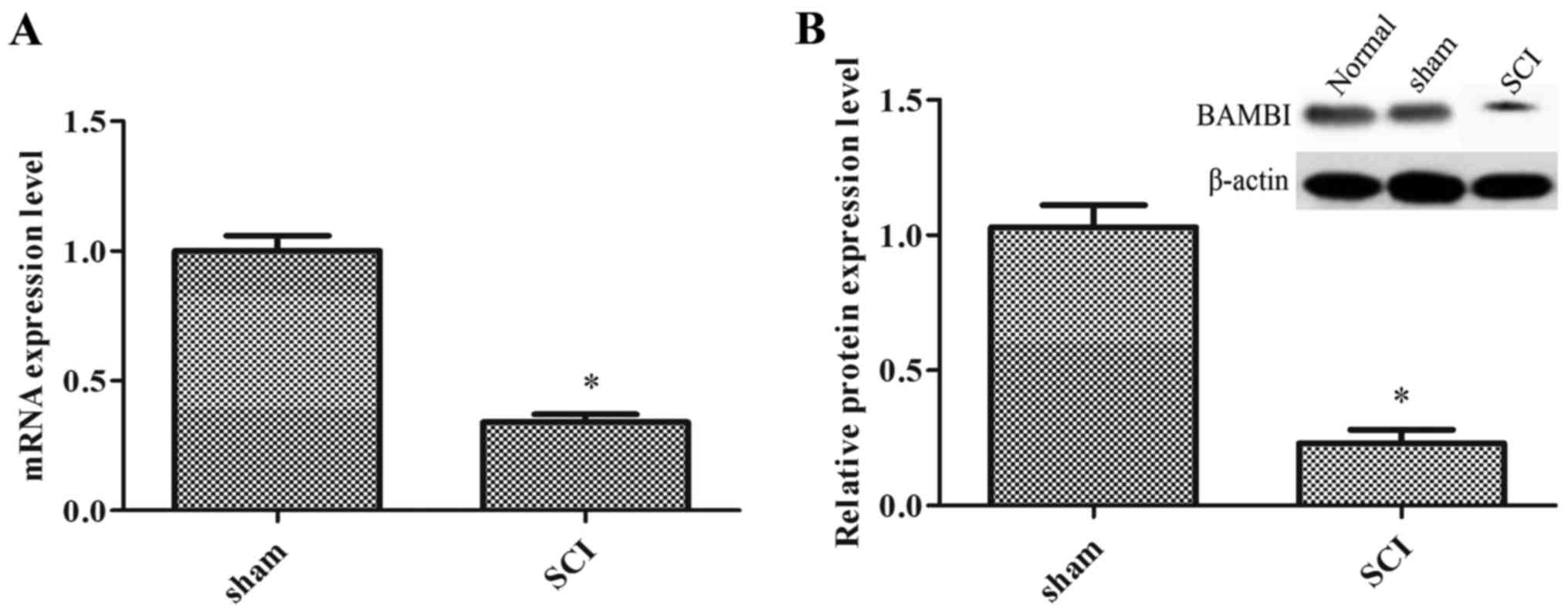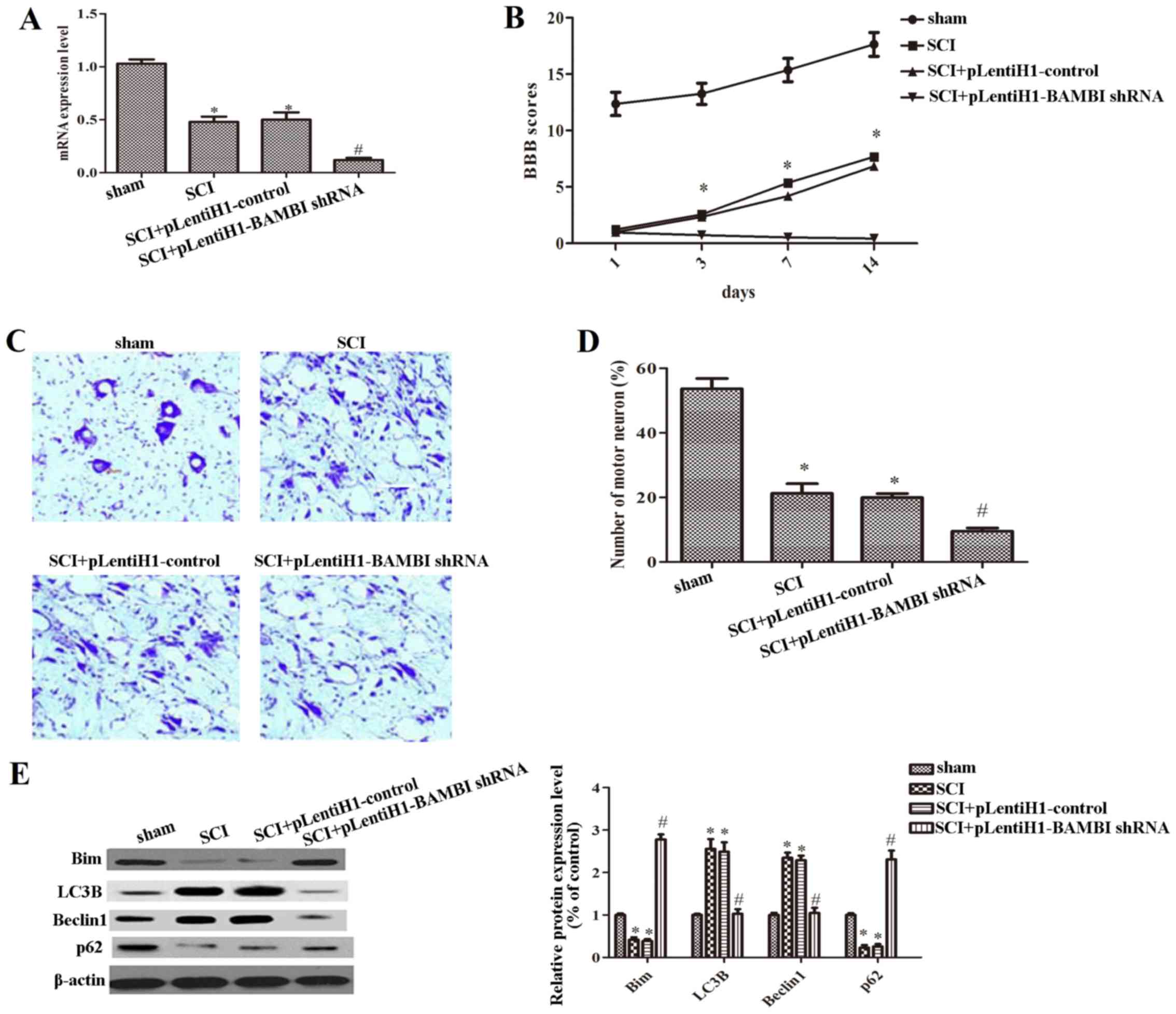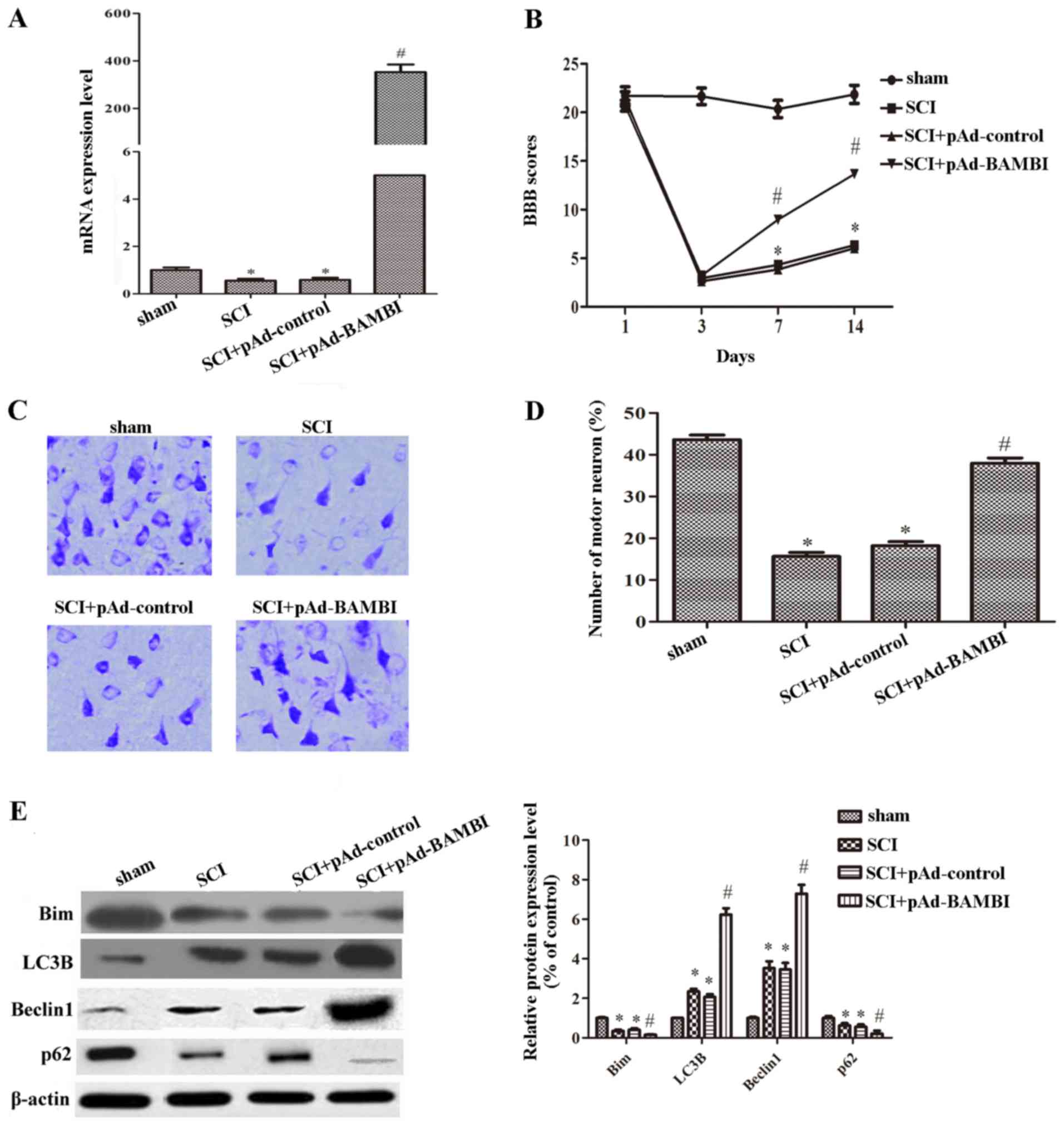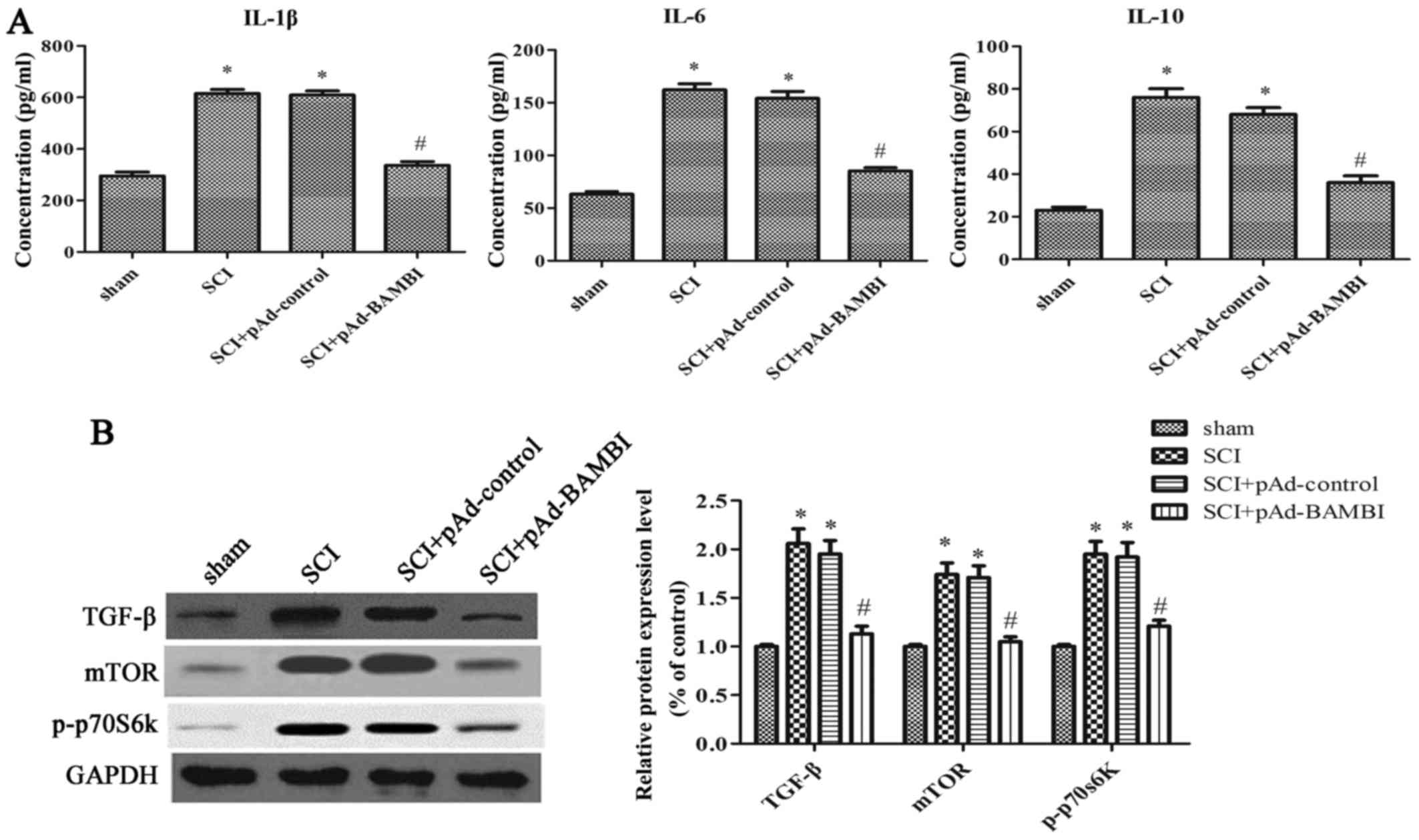|
1
|
Chen B, He J, Yang H, Zhang Q, Zhang L,
Zhang X, Xie E, Liu C, Zhang R, Wang Y, et al: Repair of spinal
cord injury by implantation of bFGF-incorporated HEMA-MOETACL
hydrogel in rats. Sci Rep. 5:90172015. View Article : Google Scholar : PubMed/NCBI
|
|
2
|
Su M, Guan H, Zhang F, Gao Y, Teng X and
Yang W: HDAC6 regulates the chaperone-mediated autophagy to prevent
oxidative damage in injured neurons after experimental spinal cord
injury. Oxid Med Cell Longev. 2016:72637362016. View Article : Google Scholar
|
|
3
|
Siracusa R, Paterniti I, Bruschetta G,
Cordaro M, Impellizzeri D, Crupi R, Cuzzocrea S and Esposito E: The
association of palmitoylethanolamide with luteolin decreases
autophagy in spinal cord injury. Mol Neurobiol. 53:3783–3792. 2016.
View Article : Google Scholar :
|
|
4
|
Wang H, Wang Y, Li D, Liu Z, Zhao Z, Han
D, Yuan Y, Bi J and Mei X: VEGF inhibits the inflammation in spinal
cord injury through activation of autophagy. Biochem Biophys Res
Commun. 464:453–458. 2015. View Article : Google Scholar : PubMed/NCBI
|
|
5
|
Li HT, Zhao XZ, Zhang XR, Li G, Jia ZQ,
Sun P, Wang JQ, Fan ZK and Lv G: Exendin-4 enhances motor function
recovery via promotion of autophagy and inhibition of neuronal
apoptosis after spinal cord injury in rats. Mol Neurobiol.
53:4073–4082. 2016. View Article : Google Scholar
|
|
6
|
Wang W, Guo Z, Xu Z, Meng Q, Chen C, Zhang
Y and Cao X: Effect of pollen typhae on inhibiting autophagy in
spinal cord injury of rats and its mechanisms. Int J Clin Exp
Pathol. 8:2375–2383. 2015.PubMed/NCBI
|
|
7
|
Perluigi M, Di Domenico F and Butterfield
DA: mTOR signaling in aging and neurodegeneration: At the crossroad
between metabolism dysfunction and impairment of autophagy.
Neurobiol Dis. 84:39–49. 2015. View Article : Google Scholar : PubMed/NCBI
|
|
8
|
Din FV, Valanciute A, Houde VP, Zibrova D,
Green KA, Sakamoto K, Alessi DR and Dunlop MG: Aspirin inhibits
mTOR signaling, activates AMP-activated protein kinase, and induces
autophagy in colorectal cancer cells. Gastroenterology.
142:1504–1515.e1503. 2012. View Article : Google Scholar : PubMed/NCBI
|
|
9
|
Patel AS, Lin L, Geyer A, Haspel JA, An
CH, Cao J, Rosas IO and Morse D: Autophagy in idiopathic pulmonary
fibrosis. PLoS One. 7:e413942012. View Article : Google Scholar : PubMed/NCBI
|
|
10
|
Fan Y, Li X, Xiao W, Fu J, Harris RC,
Lindenmeyer M, Cohen CD, Guillot N, Baron MH, Wang N, et al: BAMBI
elimination enhances alternative TGF-β signaling and glomerular
dysfunction in diabetic mice. Diabetes. 64:2220–2233. 2015.
View Article : Google Scholar : PubMed/NCBI
|
|
11
|
Hellal F, Hurtado A, Ruschel J, Flynn KC,
Laskowski CJ, Umlauf M, Kapitein LC, Strikis D, Lemmon V, Bixby J,
et al: Microtubule stabilization reduces scarring and causes axon
regeneration after spinal cord injury. Science. 331:928–931. 2011.
View Article : Google Scholar : PubMed/NCBI
|
|
12
|
Kohta M, Kohmura E and Yamashita T:
Inhibition of TGF-beta1 promotes function recovery after spinal
cord injury. Neurosci Res. 65:393–401. 2009. View Article : Google Scholar : PubMed/NCBI
|
|
13
|
Hu JZ, Long H, Wu T-D, Zhou Y and Lu H-B:
The effect of estrogen-related receptor α on the regulation of
angiogenesis after spinal cord injury. Neuroscience. 290:570–580.
2015. View Article : Google Scholar : PubMed/NCBI
|
|
14
|
Yu CG, Yezierski RP, Joshi A, Raza K, Li Y
and Geddes JW: Involvement of ERK2 in traumatic spinal cord injury.
J Neurochem. 113:131–142. 2010. View Article : Google Scholar : PubMed/NCBI
|
|
15
|
Li L, Jiang HK, Li YP and Guo YP: Hydrogen
sulfide protects spinal cord and induces autophagy via miR-30c in a
rat model of spinal cord ischemia-reperfusion injury. J Biomed Sci.
22:502015. View Article : Google Scholar : PubMed/NCBI
|
|
16
|
Zhang F, Li F and Chen G: Neuroprotective
effect of apigenin in rats after contusive sipinal cord injury.
Neurol Sci. 35:583–588. 2014. View Article : Google Scholar
|
|
17
|
Jee MK, Jung JS, Im YB, Jung SJ and Kang
SK: Silencing of miR-20a is crucial for Ngn1-mediated
neuroprotection in injured spinal cord. Hum Gene Ther. 23:508–520.
2012. View Article : Google Scholar
|
|
18
|
Villar AV, García R, Llano M, Cobo M,
Merino D, Lantero A, Tramullas M, Hurlé JM, Hurlé MA and Nistal JF:
BAMBI (BMP and activin membrane-bound inhibitor) protects the
murine heart from pressure-overload biomechanical stress by
restraining TGF-β signaling. Biochim Biophys Acta. 1832:323–335.
2013. View Article : Google Scholar
|
|
19
|
Lin L, Wang Y, Liu W and Huang Y: BAMBI
inhibits skin fibrosis in keloid through suppressing TGF-β1-induced
hypernomic fibroblast cell proliferation and excessive accumulation
of collagen I. Int J Clin Exp Med. 8:13227–13234. 2015.PubMed/NCBI
|
|
20
|
Tang P, Hou H and Zhang L, Lan X, Mao Z,
Liu D, He C, Du H and Zhang L: Autophagy reduces neuronal damage
and promotes locomotor recovery via inhibition of apoptosis after
spinal cord injury in rats. Mol Neurobiol. 49:276–287. 2014.
View Article : Google Scholar
|
|
21
|
Barth S, Glick D and Macleod KF:
Autophagy: Assays and artifacts. J Pathol. 221:117–124. 2010.
View Article : Google Scholar : PubMed/NCBI
|
|
22
|
Kanno H, Ozawa H, Sekiguchi A and Itoi E:
Spinal cord injury induces upregulation of Beclin 1 and promotes
autophagic cell death. Neurobiol Dis. 33:143–148. 2009. View Article : Google Scholar
|
|
23
|
Sekiguchi A, Kanno H, Ozawa H, Yamaya S
and Itoi E: Rapamycin promotes autophagy and reduces neural tissue
damage and locomotor impairment after spinal cord injury in mice. J
Neurotrauma. 29:946–956. 2012. View Article : Google Scholar
|
|
24
|
Luo S, Garcia-Arencibia M, Zhao R, Puri C,
Toh PP, Sadiq O and Rubinsztein DC: Bim inhibits autophagy by
recruiting Beclin 1 to microtubules. Mol Cell. 47:359–370. 2012.
View Article : Google Scholar : PubMed/NCBI
|
|
25
|
Ruppert SM, Li W, Zhang G, Carlson AL,
Limaye A, Durum SK and Khaled AR: The major isoforms of Bim
contribute to distinct biological activities that govern the
processes of autophagy and apoptosis in interleukin-7 dependent
lymphocytes. Biochim Biophys Acta. 1823:1877–1893. 2012. View Article : Google Scholar : PubMed/NCBI
|
|
26
|
Moscat J and Diaz-Meco MT: Feedback on
fat: p62-mTORC1-autophagy connections. Cell. 147:724–727. 2011.
View Article : Google Scholar : PubMed/NCBI
|
|
27
|
Saitoh Y, Fujikake N, Okamoto Y, Popiel
HA, Hatanaka Y, Ueyama M, Suzuki M, Gaumer S, Murata M, Wada K and
Nagai Y: p62 plays a protective role in the autophagic degradation
of polyglutamine protein oligomers in polyglutamine disease model
flies. J Biol Chem. 290:1442–1453. 2015. View Article : Google Scholar :
|
|
28
|
Matsuzawa Y, Oshima S, Takahara M,
Maeyashiki C, Nemoto Y, Kobayashi M, Nibe Y, Nozaki K, Nagaishi T,
Okamoto R, et al: TNFAIP3 promotes survival of CD4 T cells by
restricting MTOR and promoting autophagy. Autophagy. 11:1052–1062.
2015. View Article : Google Scholar : PubMed/NCBI
|
|
29
|
Desantis A, Bruno T, Catena V, De Nicola
F, Goeman F, Iezzi S, Sorino C, Ponzoni M, Bossi G, Federico V, et
al: Che-1-induced inhibition of mTOR pathway enables stress-induced
autophagy. EMBO J. 34:1214–1230. 2015. View Article : Google Scholar : PubMed/NCBI
|
|
30
|
Park KK, Liu K, Hu Y, Smith PD, Wang C,
Cai B, Xu B, Connolly L, Kramvis I, Sahin M and He Z: Promoting
axon regeneration in the adult CNS by modulation of the PTEN/mTOR
pathway. Science. 322:963–966. 2008. View Article : Google Scholar : PubMed/NCBI
|
|
31
|
Codeluppi S, Svensson CI, Hefferan MP,
Valencia F, Silldorff MD, Oshiro M, Marsala M and Pasquale EB: The
Rheb-mTOR pathway is upregulated in reactive astrocytes of the
injured spinal cord. J Neurosci. 29:1093–1104. 2009. View Article : Google Scholar : PubMed/NCBI
|
|
32
|
Gingery A, Bradley EW, Pederson L, Ruan M,
Horwood NJ and Oursler MJ: TGF-β coordinately activates
TAK1/MEK/AKT/NFκB and SMAD pathways to promote osteoclast survival.
Exp Cell Res. 314:2725–2738. 2008. View Article : Google Scholar : PubMed/NCBI
|













